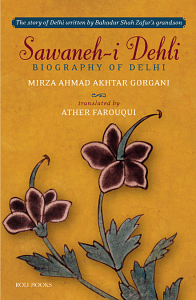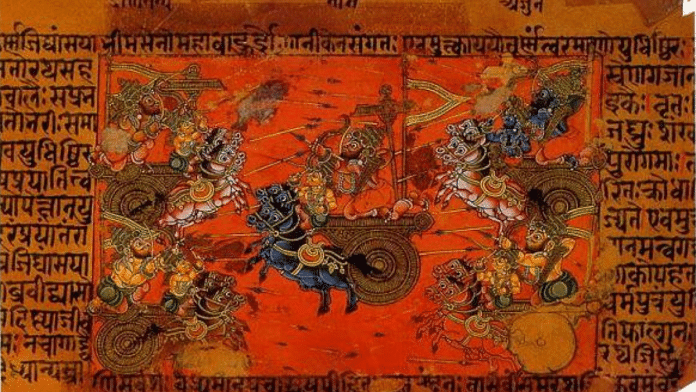In the ancient texts scribed by old Indian historians, Dehli is described as an ancient and holy city which was the abode of the gods, a sacred spot where Lord Indra celebrated an event known as Rahas, for merry-making, along with fellow gods. According to Dilli Mahatam, Dehli is a holy city and a pilgrimage centre for Indians, like Benaras, Allahabad and Haridwar, among others; and gods, like in many other [sacred] places, live here. By gods are meant the dwellers of the heavens. As mentioned in the book, many hallowed saints dwelt and performed their rituals of worship here. Living and dying in Dehli was supposed to be a blessing. A few miles from the city is the spot where the great sage Vishwamitra used to live, pray and worship. The site was earlier known as Prabhashkund but has now become known as Surajkund. However, the settlement around was known as Sohna. The same town later came to be called Indraprastha, after Lord Indra, the highest-ranking among the gods. Thus the original name of Dehli was Indraprastha. It attained great popularity and hence was known as Sohna, meaning lovely. Afterwards, Sohna has been translated as Dilli, meaning heart-touching. Some people say that Dehli was named after the ruler Raja Dalpal while others say that it gets its name from a marshland (dal-dal), but it is situated on a hilly tract. Be that as it may, the city’s population now comprises the old and the new, and according to some estimates, its territory now extends over a total length of 12 to 13 kos and a width of 5 to 6 kos. Moreover, an area extending over some 500 kos is known as Dilli Mandal Des.
Dehli being an old and revered place, the Pandavas had shifted their capital to the city from Hastinapur. Unfortunately, the Hindus did not correctly document their history. Therefore it is hard to talk with any certainty about Dehli’s foundation and its early inhabitation. It is also difficult to ascertain this ancient city’s exact age. However, the buildings that are still in existence – and the ruins of several others – reveal that it is one of the oldest cities in the Indian subcontinent and the world. The old fort used to be called Inderpat during the days of the Hindu rulers. In Sher Shah’s time, it came to be known as Shergarh, and during Humayun’s reign, it became Din Panah. Thus it acquired several names across epochs. According to legend, certain buildings were erected during the time of Emperor Ashoka,
who ruled around 332BC3 in Magadh. After that, there were many modifications in the locations and names given to Dehli, but no authentic account is available. That was a dark
age in the annals of history.
Still, some history books confirm that long after the Pandavas and Kauravas, Raja Anangpal Tomar built a city and a fort in the year 1223 in his name. Later, in 580 AH (1184), Raja Prithviraj [Chauhan] built a fortress, a palace, an orchard, and a leisure retreat, whose remains are still evident in the village of Mehrauli. His palace and place of worship have survived till this time. According to several historians, it was Prithviraj who built the first storey of Qutub Minar in order to perform his daily ritual of worshipping the rising sun before taking his first meal of the day. Notably, Qutub Minar is a famous monument in Dehli and across the entire country.
The invasions of Shihabuddin [Muhammad] Ghori led to the advent of Islam in India. The joint forces of Prithviraj and other Hindu kings repulsed the first massive invasion in
the year 587 AH [1191] at Tarawadi [modern-day Taraori]. But the invader returned the following year with a much larger force at his command, resulting in the Hindu rajas’
downfall on the same battlefield. Khande Rao, known for his exceptional gallantry and courage, was killed, and Prithviraj was taken prisoner on the banks of Saraswati River. Thus, the absolute downfall of Hindu rulers and chieftains began. The Muslim success at Tarawadi shook the very foundations of Hindu power. After that, they were fated to lose sovereignty, power, and supremacy for all time to come and could never flourish again. In the year 589 AH [1194], the defeat of Jai Chand, a cousin brother of Prithviraj, drove the final nail in the coffin of Hindu rule in India.
Ghori himself chose to return home after handing over the reins of governance to Qutbuddin Aibak, his favourite slave, to rule India on his behalf. This led to the foundation of the Sultanate of Dehli, with Qutbuddin as the first ruler of the Slave dynasty. Following his demise, his son Aram Shah took over for a brief period but being addicted to a life of ease and luxury, he proved to be an incapable ruler and was deposed. Turkish chiefs then chose Shamsuddin Altamash [also Iltutmish], a talented slave of Aibak, to take over the reins of the Sultanate. Altamash being pious, wise and efficient, proved to be a benign ruler. He introduced numerous schemes for the welfare of the people and took up campaigns for further expansion and consolidation of the new empire. He also built the famous Qutub Minar in Dehli, naming it after his mentor Qutbuddin Aibak.
Later, internal strife and internecine quarrels caused instability and unrest until Sultan Nasiruddin Mahmud took over the sultanate’s reins in 644 AH [1246]. His was a period of overall prosperity for the subjects. His wise and capable minister Ghiyasuddin Balban played an active role in governance. Balban organized the whole state and remarkably improved the conditions in Dehli’s capital. He named Dehli Marzghan.
During those times, several princes and [deposed] rulers from Central Asian states arrived in Dehli and sought refuge to escape the terror of the Mongols – the clan of Genghis Khan, the great conqueror of his time. Balban got the refugee princes settled in different parts of Dehli and created space for them by establishing localities and colonies under their names.
 This excerpt from Sawaneh-i Dehli by Mirza Ahmad Akhtar Gorgani has been published with permission from Roli Books.
This excerpt from Sawaneh-i Dehli by Mirza Ahmad Akhtar Gorgani has been published with permission from Roli Books.



